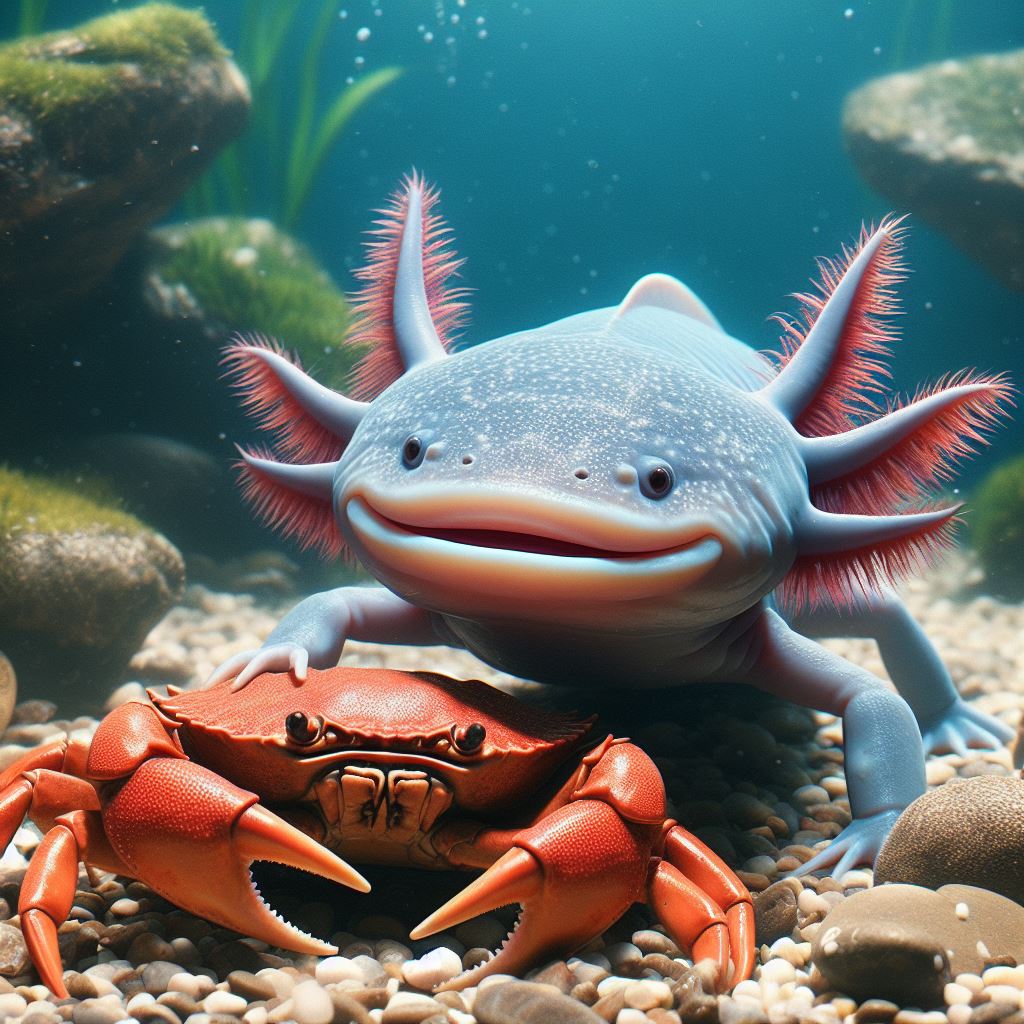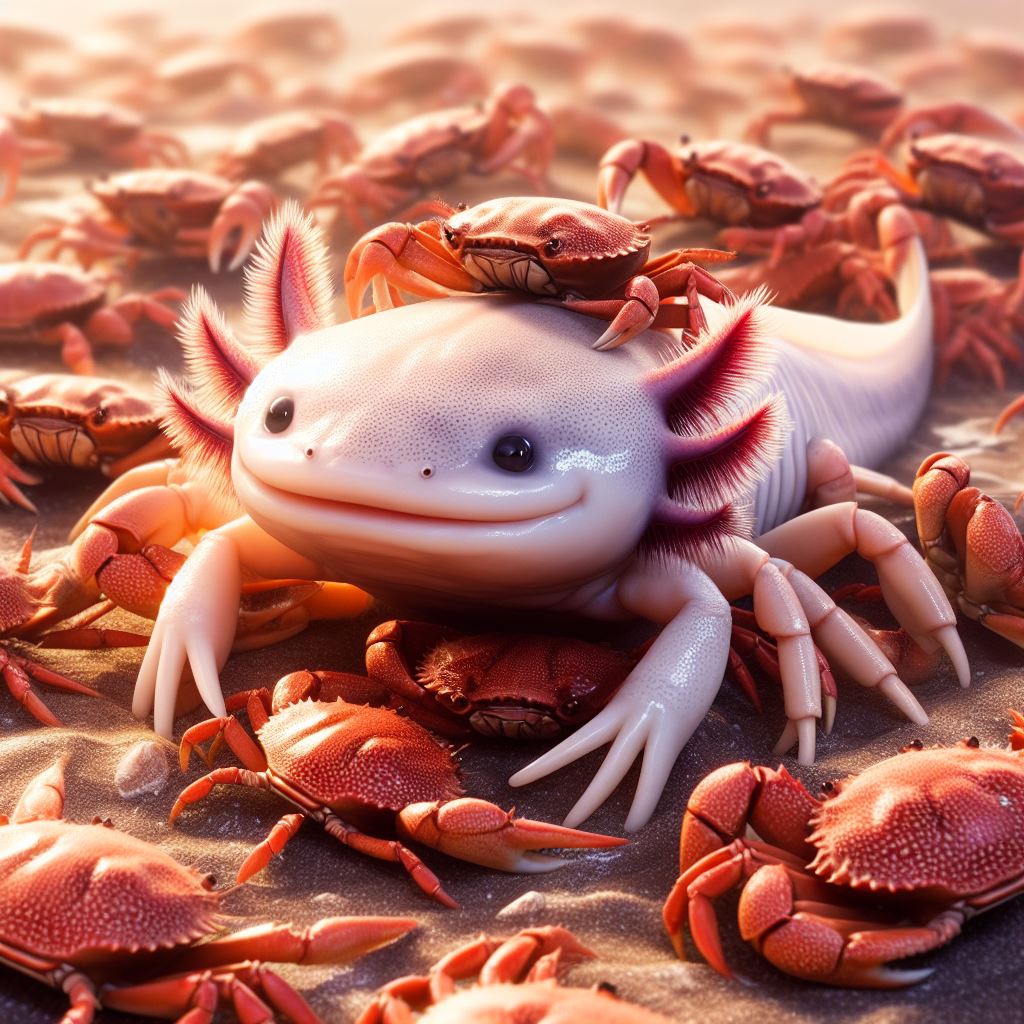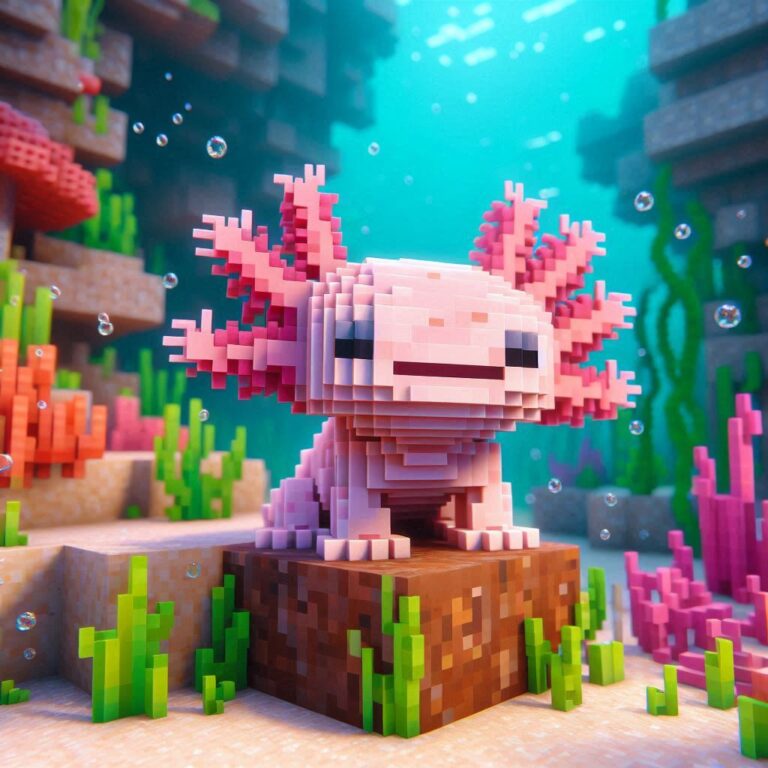
Whether axolotls can live with crabs is a question that often arises among aquarists considering mixed-species tanks. While it’s theoretically possible for them to coexist, it’s generally not recommended due to significant differences in habitat requirements, behavior, and dietary preferences. Axolotls are amphibians that thrive in cool, clean water with soft substrates and ample hiding spots. In contrast, crabs are typically found in marine or brackish environments, requiring different water parameters and substrates. Additionally, some crab species can be territorial or aggressive, posing a risk to the more delicate axolotls. Even if aggression is not an issue, there’s a risk of axolotls preying on smaller crabs, potentially leading to injury or death. Therefore, while it’s tempting to create a diverse aquarium ecosystem, it’s essential to prioritize the well-being of each species and provide them with suitable environments to thrive individually.
Habitat Requirements: Axolotls vs. Crabs
Axolotls and crabs, despite both being aquatic creatures, hail from vastly different habitats. Axolotls, native to the ancient lakes of Mexico, thrive in cool, oxygen-rich waters with temperatures ranging from 16 to 18 degrees Celsius. They prefer soft substrates like sand or smooth gravel, which are gentle on their sensitive skin. Crabs, on the other hand, inhabit a variety of marine and brackish environments worldwide, from sandy beaches to rocky shorelines. They require saltwater or brackish conditions, with some species even needing access to land for part of their life cycle. These differing habitat preferences pose a significant challenge when considering cohabitation in a shared tank. Meeting the needs of both species simultaneously can be complex and may require compromise or separate tank setups.
Tank Size
When considering housing axolotls and crabs together, tank size is paramount. Axolotls are relatively large amphibians that can grow up to a foot in length, requiring ample space to move and explore. A general rule of thumb is to provide a minimum of 20 gallons of water per axolotl, with additional space needed for each crab. Crabs, depending on the species, may vary in size and activity level, but they also need sufficient room to roam and molt. A larger tank not only accommodates the physical size of the inhabitants but also helps dilute waste and maintain water quality, crucial for the health of both axolotls and crabs.
Substrate
Choosing the right substrate is essential for creating a suitable habitat for axolotls and crabs. Axolotls prefer soft substrates that won’t injure their delicate underbellies as they explore the tank bottom. Sand or fine gravel are ideal choices, allowing axolotls to burrow and sift through the substrate in search of food. However, crabs may have different substrate preferences based on their natural habitat. Some species prefer sandy substrates for burrowing, while others may prefer a mix of sand and rocks for climbing and hiding. Providing a varied substrate can cater to the needs of both species, with designated areas for burrowing, climbing, and foraging.
Hiding Places
Creating ample hiding places is crucial for reducing stress and promoting natural behaviors in both axolotls and crabs. Axolotls are nocturnal creatures that appreciate secluded spots to retreat to during the day. Adding caves, plants, and driftwood provides shelter and security for axolotls, allowing them to rest undisturbed. Similarly, crabs require hiding places to feel safe and secure, especially during molting or when they feel threatened. Providing caves, rocks, and artificial structures creates a diverse environment that caters to the natural instincts of both axolotls and crabs. Additionally, these hiding places help reduce aggression by providing escape routes and territorial boundaries, promoting a harmonious coexistence in the shared tank.
Crab Behavior: How It Affects Axolotls
Understanding crab behavior is crucial when considering housing them with axolotls. Crabs exhibit a range of behaviors influenced by their species, environment, and social interactions. Some crab species are known for their territorial tendencies, aggressively defending their space from perceived intruders. This aggression can stress out axolotls, leading to decreased appetite, hiding, or even physical injuries. Additionally, crabs are opportunistic scavengers and may compete with axolotls for food resources, further impacting their well-being. Conversely, certain crab species may exhibit more docile behavior, coexisting peacefully with axolotls. Therefore, careful consideration of crab behavior is essential to ensure a compatible tank environment for both species.
Aggressiveness
The level of aggressiveness exhibited by crabs can significantly impact the well-being of axolotls sharing the same tank. Some crab species, such as fiddler crabs or red claw crabs, are known for their territorial behavior, particularly males defending their burrows or mating territories. When introduced into a shared tank, these aggressive tendencies can lead to confrontations with axolotls, potentially resulting in injury or stress. Even seemingly harmless crabs can become aggressive when resources are scarce or during mating season. Therefore, it’s essential to research the behavior of the specific crab species and monitor interactions closely to prevent conflicts and ensure the safety of both axolotls and crabs.
Feeding Habits
Crabs have diverse feeding habits influenced by their natural environment and dietary preferences. While some crab species are primarily herbivorous, feeding on algae, plants, and detritus, others are omnivorous or carnivorous, scavenging on small animals, fish, or carrion. This variation in feeding habits can impact the availability of food resources in a shared tank with axolotls. Axolotls are carnivorous amphibians that primarily feed on live or frozen meaty foods such as bloodworms, earthworms, and small fish. Competition for food between axolotls and crabs may arise if their dietary preferences overlap or if one species outcompetes the other for food. Therefore, careful consideration of feeding habits and providing a varied diet for both axolotls and crabs is essential to ensure their nutritional needs are met without causing conflict.
Compatibility with Axolotls
Determining the compatibility of crab species with axolotls is crucial for creating a harmonious tank environment. Some crab species may coexist peacefully with axolotls, exhibiting non-aggressive behavior and minimal competition for resources. For example, freshwater crabs like Thai micro crabs or vampire crabs are known for their relatively peaceful temperament and small size, making them suitable tankmates for axolotls in spacious setups. However, other crab species, particularly larger or more aggressive varieties, may pose a risk to axolotls due to territorial behavior, competition for food, or potential predation. It’s essential to research the specific compatibility of crab species with axolotls and observe their interactions closely when introduced into the same tank. Providing ample hiding places, ensuring sufficient space, and monitoring for signs of aggression or stress can help facilitate a successful coexistence between axolotls and compatible crab species.
Dietary Differences Between Axolotls and Crabs
Understanding the dietary differences between axolotls and crabs is essential when considering housing them together in the same tank. Axolotls are carnivorous amphibians with a primarily meat-based diet. They feed on a variety of live or frozen foods, including bloodworms, earthworms, small fish, and aquatic insects. Axolotls are opportunistic feeders, relying on their keen sense of smell and motion detection to hunt prey. In contrast, crabs have diverse dietary preferences depending on their species and habitat. While some crab species are herbivorous, feeding on algae and plant matter, others are omnivorous or even carnivorous, consuming small animals, fish, or carrion. These dietary differences can lead to competition for food resources in a shared tank, potentially impacting the health and well-being of both axolotls and crabs.
Axolotl Diet
Axolotls have specific dietary requirements to maintain optimal health and growth. As carnivorous amphibians, axolotls require a diet rich in protein and essential nutrients. Live or frozen meaty foods such as bloodworms, earthworms, brine shrimp, and small feeder fish are staple foods for axolotls. Providing a varied diet ensures that axolotls receive the necessary nutrients and vitamins for overall well-being. Additionally, feeding frequency can vary depending on the age and size of the axolotl, with younger individuals requiring more frequent feedings compared to adults. It’s essential to monitor the axolotl’s appetite and adjust feeding accordingly to prevent overfeeding and maintain water quality in the tank.
Crab Diet
Crab diets vary widely depending on their species and habitat. While some crab species are herbivorous, feeding primarily on algae and plant matter, others are omnivorous or carnivorous, consuming a mix of plant material, small animals, fish, or carrion. Marine crabs often scavenge for food along the shoreline, feeding on detritus, plankton, and small invertebrates. In contrast, freshwater crabs may feed on algae, aquatic plants, and small aquatic organisms found in their habitat. Understanding the specific dietary requirements of the crab species is crucial for providing appropriate nutrition and ensuring their health and well-being in captivity.
Feeding Considerations
When housing axolotls and crabs together, careful consideration of feeding practices is essential to prevent competition for food and ensure the nutritional needs of both species are met. Providing a varied diet that includes foods suitable for both axolotls and crabs can help minimize competition and support their dietary requirements. Feeding schedules may need to be adjusted based on the feeding behaviors and preferences of each species, with attention to maintaining water quality and preventing overfeeding. Additionally, offering food in separate feeding areas or at different times of the day can help reduce aggression and competition during feeding sessions. Monitoring the appetite and behavior of both axolotls and crabs is essential to ensure they receive adequate nutrition without compromising their health or well-being in the shared tank environment.
Potential Risks of Housing Axolotls and Crabs Together
While the idea of creating a diverse aquatic ecosystem with axolotls and crabs may seem appealing, there are several potential risks to consider when housing these species together. Understanding and mitigating these risks are essential for maintaining the health and well-being of both axolotls and crabs in a shared tank environment.
Injury Risk
One of the primary risks of housing axolotls and crabs together is the potential for injuries to occur. Axolotls have delicate skin and may be vulnerable to injury from the sharp claws or pincers of crabs, especially during confrontations or territorial disputes. Similarly, crabs may also sustain injuries from aggressive interactions with axolotls or from being inadvertently crushed or bitten. These injuries can lead to stress, infections, or even death for both axolotls and crabs, highlighting the importance of careful monitoring and management of their interactions in the tank.
Competition for Resources
Another significant risk of cohabitating axolotls and crabs is the competition for resources, including food, shelter, and territory. Both species have distinct dietary preferences and feeding behaviors, which can lead to conflicts over limited food resources in the tank. Additionally, competition for hiding places and territorial spaces may arise, particularly if the tank is not adequately furnished with suitable hiding spots and partitions. Competition for resources can cause stress, malnutrition, and aggression among axolotls and crabs, impacting their overall health and well-being.
Disease Transmission
Disease transmission is a potential risk when housing axolotls and crabs together, particularly if one species carries pathogens or parasites that could affect the other. Crabs may harbor bacterial or fungal infections that could be transmitted to axolotls through direct contact or contaminated water. Similarly, axolotls may carry diseases or parasites that could affect the health of crabs in the tank. Poor water quality or stress can further increase the susceptibility of both species to disease. Regular monitoring of water parameters, quarantine procedures for new additions, and prompt treatment of any signs of illness are essential measures for minimizing the risk of disease transmission in a mixed-species tank.
Temperature and Water Quality Considerations

Maintaining optimal temperature and water quality is crucial for the health and well-being of both axolotls and crabs in a shared tank environment. Temperature influences metabolic rates, immune function, and overall activity levels of aquatic organisms, while water quality parameters such as pH, ammonia, nitrite, and nitrate levels directly impact their physiological processes and stress tolerance. Understanding and managing these factors are essential for creating a suitable habitat that meets the needs of both axolotls and crabs.
Temperature Needs
Axolotls and crabs have different temperature requirements due to their distinct natural habitats and physiological adaptations. Axolotls are cold-water amphibians native to the cool, oxygen-rich waters of Mexico, preferring temperatures between 16 to 18 degrees Celsius. In contrast, crabs are ectothermic crustaceans with temperature preferences influenced by their species and habitat. Marine crabs typically inhabit warmer waters, while freshwater crabs may prefer slightly cooler temperatures. Finding a temperature range that accommodates the needs of both species can be challenging but essential for promoting their health and well-being in a shared tank.
Water Quality Parameters
Maintaining proper water quality parameters is essential for creating a healthy aquatic environment for axolotls and crabs. Key parameters to monitor include pH, ammonia, nitrite, and nitrate levels, as well as temperature and dissolved oxygen content. Axolotls are particularly sensitive to ammonia and nitrite toxicity, which can result from inadequate filtration or overfeeding. Crabs are also sensitive to changes in water quality, with high ammonia levels or fluctuating pH potentially causing stress or health issues. Regular water testing, proper filtration, and routine maintenance are essential for ensuring stable water quality and minimizing the risk of waterborne diseases or stress-related issues in both axolotls and crabs.
Compatibility of Requirements
Achieving compatibility between the temperature and water quality requirements of axolotls and crabs is essential for their cohabitation in a shared tank. While axolotls prefer cooler water temperatures, crabs may have slightly different temperature preferences based on their species and natural habitat. Finding a temperature range that falls within the tolerance limits of both species is crucial for promoting their health and well-being. Similarly, maintaining stable water quality parameters that meet the needs of both axolotls and crabs requires careful monitoring and management of filtration, feeding practices, and tank maintenance routines. By prioritizing compatibility and stability in temperature and water quality, aquarists can create a thriving habitat that supports the health and vitality of both axolotls and crabs in a shared tank environment.
FAQs
Q. Can axolotls and crabs live together peacefully?
A. While it’s possible for them to coexist, it’s not recommended due to potential conflicts and differences in habitat requirements.
Q. Do axolotls eat crabs?
A. Axolotls may try to eat crabs, especially if they’re small enough to fit in their mouths. This can lead to injury or even death for the crab.
Q. What size tank do I need to house axolotls and crabs together?
A. A large tank is essential to provide enough space for both species. A minimum of 20 gallons per axolotl is recommended, with additional space for crabs.
Q. Are crabs aggressive towards axolotls?
A. Some crab species can be territorial or aggressive, which can stress out axolotls and lead to conflicts. It’s crucial to research the specific behavior of the crab species you intend to keep.
Q. Can axolotls and crabs share the same water parameters?
A. Axolotls and crabs have somewhat different water parameter requirements. While axolotls prefer cooler water temperatures, crabs may require slightly warmer conditions. It’s essential to find a balance that suits both species.
Q. Do axolotls and crabs need the same type of substrate?
A. Axolotls prefer a soft substrate, such as sand or fine gravel, to prevent injury to their delicate skin. Crabs may prefer a mix of sand and rocks for burrowing and climbing. Providing separate areas with suitable substrates is advisable.
Q. What are the signs that axolotls and crabs aren’t compatible?
A. Aggressive behavior, stress indicators such as loss of appetite or hiding, and physical injuries to either species are signs that they may not be compatible.
Q. How do I prevent axolotls from eating crabs?
A. Providing ample hiding places and ensuring the crabs have spaces inaccessible to axolotls can help minimize the risk of predation. Additionally, feeding the axolotls a varied diet can reduce their interest in hunting.
Q. Can crabs transmit diseases to axolotls?
A. While it’s less common for crabs to transmit diseases to axolotls, it’s still a risk, especially if the water quality is not adequately maintained. Quarantining new crabs before introducing them to the tank can help mitigate this risk.
Q. What should I do if I notice aggression between my axolotls and crabs?
A. If aggression occurs, separate the individuals involved immediately to prevent injuries. Reevaluate the tank setup to ensure it meets the needs of both species, and consider housing them separately if conflicts persist.
Conclusion
In conclusion, while the idea of housing axolotls and crabs together in a shared tank may seem appealing, it comes with inherent challenges and risks. Understanding the unique habitat requirements, behaviors, and dietary preferences of both species is essential for creating a harmonious and thriving aquatic ecosystem. From temperature and water quality considerations to managing potential risks such as injury, competition for resources, and disease transmission, careful planning and diligent monitoring are crucial for the well-being of axolotls and crabs in captivity.

Hassan Shah carries over four years of hands-on expertise in caring for axolotls, guided by his cherished companion ‘Little Bruno,’ a thriving axolotl under his attentive care for three years.



